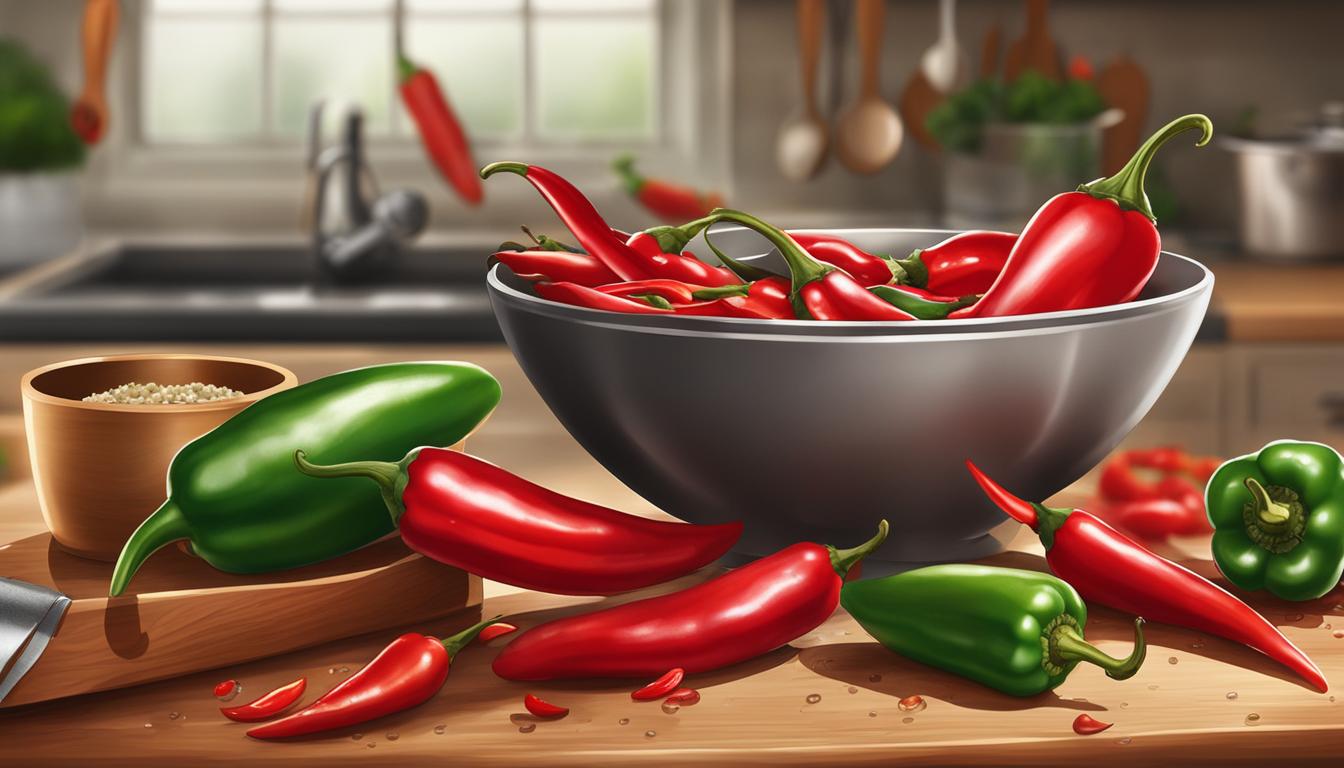Welcome to a world of flavor and wellness! Discover the incredible versatility and health benefits of cayenne pepper. This powerful spice isn’t just for adding heat to your dishes; it also offers a wide range of uses and medicinal properties.
With its rich nutrient profile, including vitamins A, E, C, B6, and K, as well as manganese and potassium, cayenne pepper has been cherished for centuries for its healing properties. Let’s explore how this vibrant spice can enhance your life in multiple ways.
From aiding digestion and weight loss to providing pain relief and acting as a natural anti-inflammatory, cayenne pepper has a multitude of benefits that can support your overall well-being. Whether you’re looking to spice up your meals or find natural remedies for various ailments, cayenne pepper has a place in your pantry.
Join us as we delve into the fascinating world of cayenne pepper and uncover its remarkable uses and benefits. Whether you’re a culinary enthusiast or someone seeking natural solutions, get ready to ignite your taste buds and energize your mind, body, and soul with the power of cayenne pepper!
What Are Cayenne Peppers?
Cayenne peppers are a type of chili pepper that is closely related to bell peppers and jalapeños. They contain capsaicin, which is responsible for their hot taste and medicinal properties. The level of spiciness in a cayenne pepper depends on its capsaicin content.

Comparison of Cayenne Pepper Scoville Heat Units
| Cayenne Pepper Variety | Scoville Heat Units |
|---|---|
| Average Cayenne Pepper | 30,000 – 50,000 |
| Jalapeño Pepper | 2,500 – 8,000 |
| Bell Pepper | 0 |
| Ghost Pepper | 855,000 – 1,041,427 |
As seen in the table above, cayenne peppers fall within the range of 30,000 to 50,000 Scoville Heat Units, making them hotter than jalapeño peppers but milder than ghost peppers.
“Cayenne peppers add a fiery kick to dishes and provide numerous health benefits due to their capsaicin content.”
With their vibrant color and spicy flavor, cayenne peppers are a versatile ingredient that can enhance the taste and nutritional value of various dishes. Incorporating them into your diet can provide you with a range of benefits, from boosting metabolism to promoting digestive health.
- Rich in vitamins A, E, C, B6, and K
- High in manganese and potassium
- May aid in weight loss by boosting metabolism
- Potential benefits for heart health and blood pressure
- May alleviate pain and reduce inflammation
- Can enhance circulation and promote detoxification
- Possible antifungal and antibacterial properties
Cayenne Pepper Benefits
Cayenne pepper offers a wide range of health benefits that can enhance your overall well-being. From boosting metabolism to relieving pain, this versatile spice has been used for centuries for its medicinal properties.
Boosting Metabolism and Weight Loss
One of the key benefits of cayenne pepper is its ability to boost metabolism. When your metabolism is increased, your body burns more calories, which can aid in weight loss. Adding cayenne pepper to your meals can give your metabolism the kick-start it needs to help you achieve your weight loss goals.
Lowering Blood Pressure
Cayenne pepper has the potential to lower blood pressure. Studies have shown that capsaicin, the active compound in cayenne pepper, may help dilate blood vessels and improve circulation. This can help reduce blood pressure levels and promote heart health.
Aiding Gut Health
Cayenne pepper has been found to increase the production of digestive fluids in the stomach, which can improve digestion and promote gut health. By aiding in the breakdown and absorption of nutrients, cayenne pepper can support a healthy digestive system and prevent digestive issues.
Relieving Pain
The pain-relieving properties of cayenne pepper make it a popular natural remedy. Topical creams or ointments containing capsaicin can be applied to the skin to provide relief from pain, such as arthritis or muscle soreness. The heat generated by capsaicin helps to block pain signals and reduce inflammation.
Improving Psoriasis
Cayenne pepper has shown promise in improving the symptoms of psoriasis, a chronic skin condition characterized by red, itchy, and scaly patches. The antioxidant and anti-inflammatory properties of cayenne pepper can help soothe the skin, reduce redness, and alleviate the discomfort associated with psoriasis.
Increasing Circulation
Improved circulation is another benefit of cayenne pepper. By promoting blood flow and reducing clot formation, cayenne pepper can enhance overall circulation in the body. This can have a positive impact on heart health and reduce the risk of cardiovascular diseases.
Antifungal and Antibacterial Benefits
Cayenne pepper possesses antifungal and antibacterial properties, which can help fight against various infections. The active compound capsaicin present in cayenne pepper has demonstrated antimicrobial effects against bacteria and fungi, making it a natural defense against harmful pathogens.
Natural Decongestant
If you’re suffering from a stuffy nose or congestion, cayenne pepper can provide relief as a natural decongestant. It helps to thin mucus and stimulate the release of fluids, clearing nasal passages and alleviating discomfort.
With its numerous health benefits, cayenne pepper is a powerful spice that can improve your overall well-being. Incorporate it into your diet or use it topically to experience the natural healing properties of this versatile ingredient.
How to Use Cayenne Pepper For Its Full Benefits
Cayenne pepper is a versatile spice that can be easily incorporated into your diet, offering a wide range of health benefits. Whether you prefer a mild kick or a fiery explosion of flavor, cayenne pepper can add a bold twist to your favorite dishes. Here are some creative ways to incorporate cayenne pepper into your meals:
- Add a pinch of cayenne pepper to soups and stews for an extra layer of depth and heat.
- Sprinkle cayenne pepper on your morning eggs for a zesty start to your day.
- Mix cayenne pepper into hummus for a spicy twist on a classic dip.
- Indulge in a cup of hot chocolate with a dash of cayenne pepper for a warm and fiery treat.
- Make a refreshing glass of lemonade with a hint of cayenne pepper for a tangy and spicy beverage.
- Spice up your chili recipe by adding cayenne pepper for an extra kick.
- Add cayenne pepper to seafood dishes to complement the natural flavors of the ocean.
- Marinate your meats with cayenne pepper for a spicy and flavorful twist.
- Whip up homemade salad dressings with cayenne pepper to give your salads a fiery kick.
- Create your own hot sauce using cayenne pepper for a personalized heat level.
- Dip your favorite finger foods in sauces infused with cayenne pepper for a spicy sensation.
- Sprinkle cayenne pepper on corn for a spicy side dish at your next barbecue.
- Enhance the flavors of curry dishes with the bold heat of cayenne pepper.
- Add cayenne pepper to the breadcrumb mixture for fried foods for an extra layer of flavor.
- Boost your detox routine by incorporating cayenne pepper into your tea or water.
- Stir cayenne pepper into your pasta sauce for a spicy pasta dish that will leave your taste buds tingling.
- Spice up your potato dishes by adding cayenne pepper for an extra kick.
Aside from its use in cooking, cayenne pepper can also be taken in the form of supplements or used topically in creams for various health benefits. Cayenne pepper supplements are available in capsule or tablet form and can be taken as a convenient way to incorporate the spice into your daily routine. Topical creams infused with cayenne pepper can provide targeted relief for pain and inflammation.
Incorporating cayenne pepper into your diet and lifestyle is a flavorful way to reap its full benefits. Whether you prefer subtle heat or intense spiciness, cayenne pepper has something to offer everyone. So go ahead and spice things up with the incredible power of cayenne pepper!

What is Cayenne Pepper?
Cayenne pepper, scientifically known as Capsicum annum, is a long, thin pepper with a bright red color. It has a slightly sweet and smoky taste underneath its spiciness. On the Scoville scale, cayenne pepper ranks between 30,000 to 50,000 Scoville Heat Units, making it hotter than a jalapeño pepper.

The Taste and Heat Level of Cayenne Pepper
The distinctive taste of cayenne pepper can be described as a combination of sweetness and smokiness. This unique flavor profile adds depth to dishes, making it a popular ingredient in various cuisines.
When it comes to heat, cayenne pepper packs a punch. It falls within the range of medium to moderately high heat on the Scoville scale. The capsaicin content in cayenne peppers is responsible for its spiciness. Capsaicin is a natural compound that stimulates heat receptors in the mouth, creating a sensation of heat.
| Pepper | Scoville Heat Units |
|---|---|
| Cayenne Pepper | 30,000 to 50,000 |
| Jalapeño Pepper | 2,500 to 8,000 |
As shown in the table, cayenne pepper’s heat level surpasses that of jalapeño peppers, offering a more intense spiciness to dishes. However, it is essential to note that personal tolerance to heat can vary, so it is recommended to start with small amounts and gradually increase the quantity based on personal preference.
Cayenne Pepper Health Benefits
Cayenne pepper offers a myriad of health benefits that can enhance your overall well-being. Let’s explore the various ways this spice can improve your health:
Antioxidant Powerhouse
Cayenne pepper is packed with antioxidants, which play a crucial role in protecting the body against free radicals. These harmful molecules can damage cells and increase the risk of chronic diseases. By incorporating cayenne pepper into your diet, you can boost your antioxidant intake and promote optimal health.
Improved Digestion
Cayenne pepper is known to stimulate the secretion of gastric juices, which aids in the digestion process. It can help improve nutrient absorption, reduce bloating, and alleviate indigestion. Additionally, cayenne pepper has anti-inflammatory properties that can reduce gut inflammation and promote digestive health.
Heart Health Support
The active compound in cayenne pepper, capsaicin, has been linked to various heart health benefits. It can help lower blood pressure levels and reduce inflammation, both of which contribute to a healthy cardiovascular system. By incorporating cayenne pepper into your diet, you can support your heart health and reduce the risk of heart disease.
Weight Maintenance
If you’re looking to shed some pounds or maintain a healthy weight, cayenne pepper can be a valuable addition to your diet. It is known to boost metabolism by increasing calorie expenditure and fat oxidation. Moreover, cayenne pepper acts as a natural appetite suppressant, helping to curb cravings and control calorie intake.
Pain Relief
The capsaicin in cayenne pepper has potent analgesic properties, making it an effective natural pain reliever. When applied topically, cayenne pepper creams or ointments can alleviate muscle aches, joint pain, and even nerve pain. Internally, the consumption of cayenne pepper can provide relief from conditions like migraines and cluster headaches.
Incorporating cayenne pepper into your daily routine can offer a multitude of health benefits, from protecting against oxidative stress to supporting optimal digestion, heart health, weight management, and pain relief.

| Health Benefit | Description |
|---|---|
| Antioxidants | Protects against free radicals and promotes overall health |
| Digestion | Increases gastric juice secretion and reduces gut inflammation |
| Heart Health | Lowers blood pressure and reduces inflammation |
| Weight Maintenance | Boosts metabolism and suppresses appetite |
| Pain Relief | Provides relief from muscle aches, joint pain, and migraines |
Where Does Cayenne Pepper Come From?
Cayenne pepper, also known as Capsicum annum, has a rich history that dates back to its origins in the Cayenne region of French Guiana. However, today it is cultivated in various countries around the world, making it easily accessible for culinary and medicinal purposes. Some of the prominent cultivation regions for Cayenne pepper include:
- India
- Eastern Africa
- Central and South America
- The United States
Cayenne pepper belongs to the Capsicum annum plant family, alongside other well-known nightshade vegetables like tomatoes and eggplants. Its vibrant red color and fiery flavor make it a popular spice and ingredient in diverse cuisines globally.
Discover the fascinating journey of Cayenne pepper from its historical roots to its widespread cultivation in various regions across the globe.
The Origins of Cayenne Pepper
“Cayenne pepper brings a touch of exoticism to your dishes, but have you ever wondered where it comes from?”
Originally found in the Cayenne region of French Guiana, Cayenne pepper derives its name from this specific area. With its favorable climate and fertile soil, the Cayenne region provided the ideal conditions for the growth of these fiery peppers.
Over time, the popularity of Cayenne pepper spread, leading to its cultivation in different parts of the world. Today, it is widely recognized and enjoyed for its unique taste and various health benefits.

The Global Cultivation of Cayenne Pepper
Cayenne pepper cultivation has expanded beyond its original birthplace and can now be found in various countries and continents. These regions have embraced the production of Cayenne pepper to meet the ever-growing demand for this versatile spice.
| Region | Key Features |
|---|---|
| India | Known for its diverse spices, India cultivates a significant amount of Cayenne pepper, contributing to the country’s rich culinary traditions. |
| Eastern Africa | With its favorable climate, Eastern Africa has emerged as a prominent cultivation region for Cayenne pepper, adding a touch of heat to local dishes. |
| Central and South America | The lush landscapes of Central and South America provide an ideal environment for Cayenne pepper cultivation, making it a staple in many traditional recipes. |
| The United States | Cayenne peppers are grown in several states throughout the United States, ensuring a local supply for domestic consumption and international trade. |
Throughout these regions, farmers carefully cultivate Cayenne pepper, ensuring that the peppers reach their full potential in terms of flavor, aroma, and heat. The cultivation of Cayenne pepper has become an essential part of the agricultural industry in these areas, supporting local economies and preserving culinary traditions.
“Explore the diverse cultivation regions of Cayenne pepper and learn about the climatic conditions that contribute to its unique flavors and spiciness.”
Whether you’re savoring a spicy curry, adding a kick to your favorite salsa, or using Cayenne pepper in natural remedies, it’s fascinating to trace its origins and understand how it has traveled across the globe.
Different Forms of Cayenne Pepper
Cayenne pepper is available in different forms, each with its own unique characteristics and uses. When it comes to incorporating cayenne pepper into your cooking or daily routine, you have several options to choose from:
Fresh Peppers
Whole fresh cayenne peppers are a popular choice for those who prefer to experience the full flavor and heat of this fiery spice. These vibrant red peppers can be used in their fresh form, either raw or sautéed, to add a kick to your dishes. Fresh cayenne peppers are known for their bold and intense flavor, making them a favorite among spice enthusiasts.
Dried Peppers
Dried cayenne peppers are a convenient option that offers a longer shelf life compared to fresh peppers. The drying process intensifies the flavor and heat of the peppers, resulting in a more concentrated spice. Dried cayenne peppers can be rehydrated and used in recipes that call for a punch of heat, or they can be ground into a powder for easy incorporation into various dishes.
Ground Pepper
Ground cayenne pepper is the most commonly used form of this fiery spice. It is made by grinding dried cayenne peppers into a fine powder, allowing for easy mixing and blending into recipes. Ground cayenne pepper is versatile and can be added to soups, stews, marinades, sauces, and more, providing a consistent level of heat and flavor throughout the dish.
No matter which form of cayenne pepper you choose, the spice will add a fiery kick to your recipes and provide various health benefits. Experimenting with different forms can help you discover new ways to incorporate this versatile spice into your culinary creations.
How to Store Cayenne Pepper
Fresh cayenne peppers can add a vibrant kick to your dishes, while dried and ground cayenne pepper is a convenient way to enjoy its fiery flavor. Properly storing your cayenne pepper ensures its freshness and potency. Here are some tips on how to store cayenne pepper:
Storing Fresh Cayenne Peppers
To keep your fresh cayenne peppers crisp and flavorful, follow these steps:
- Place the fresh cayenne peppers in a perforated plastic bag to allow for air circulation.
- Store the bag of peppers in the refrigerator’s crisper drawer to maintain their freshness.
- Make sure the peppers are dry before storing to prevent mold growth.
By storing your fresh cayenne peppers in the refrigerator, you can extend their shelf life for up to two weeks while preserving their fiery flavor.
Storing Dried and Ground Cayenne Pepper
If you have dried and ground cayenne pepper, follow these guidelines to maximize its shelf life:
- Transfer the dried and ground cayenne pepper to an airtight container, preferably made of glass or metal.
- Keep the container in a cool, dry place like a pantry, away from direct sunlight and moisture.
Dried cayenne pepper can also be stored in the freezer for even longer shelf life, up to one year. Freezing helps retain its flavor and potency.

By properly storing your cayenne pepper, whether fresh, dried, or ground, you can maintain its flavor, aroma, and health benefits for an extended period. So, stock up on this versatile spice and enjoy its fiery essence in your dishes whenever you desire!
Cayenne Pepper Side Effects
While cayenne pepper offers many health benefits, it’s important to be aware of its potential side effects. Consuming cayenne pepper, particularly its active compound capsaicin, can cause irritation and a burning sensation in some individuals.
The key to enjoying the benefits of cayenne pepper without discomfort is moderation. Ensure you don’t overconsume cayenne pepper, as excessive intake can lead to more pronounced side effects.
If you have a sensitive digestive system, such as irritable bowel syndrome (IBS), it’s essential to exercise caution when incorporating cayenne pepper into your diet. For individuals with IBS, the spiciness of cayenne pepper may potentially trigger flare-ups or gastrointestinal discomfort. It’s advisable to consult with a healthcare professional before adding cayenne pepper to your IBS management plan.
Allergic reactions to cayenne pepper are rare but should still be monitored. If you experience symptoms such as itching, swelling, hives, or difficulty breathing after consuming cayenne pepper, seek medical attention immediately.
Remember, it’s always best to listen to your body and make informed decisions about incorporating cayenne pepper into your lifestyle.

Best Superfoods to Pair with Cayenne Pepper
Cayenne pepper can be further enhanced by pairing it with various superfoods, combining their unique health properties to maximize the benefits. Incorporating these superfoods into your diet can provide complementary advantages that work in synergy with the power of cayenne pepper.
Here are some examples of superfoods that pair exceptionally well with cayenne pepper:
- Turmeric: Known for its anti-inflammatory properties, turmeric complements the cayenne pepper’s pain-relieving benefits.
- Ginger: Ginger and cayenne pepper are a powerful combination for digestion. Ginger helps soothe the stomach and reduces bloating.
- Garlic: Garlic not only adds flavor but also provides immune-boosting properties. Combined with cayenne pepper, it creates a potent immune-supporting duo.
- Lemon: The tangy notes of lemon complement the spicy kick of cayenne pepper, adding a refreshing twist to any dish.
- Kale: Packed with nutrients, kale combines well with cayenne to create a superfood powerhouse supporting overall health and vitality.
- Spinach: Spinach and cayenne pepper are a dynamic duo when it comes to promoting cardiovascular health.
- Berries: Berries, rich in antioxidants, pair perfectly with cayenne pepper. The combination provides a boost of antioxidants capable of fighting free radicals in the body.
- Dark Chocolate: Dark chocolate’s decadence blends harmoniously with the spiciness of cayenne pepper, creating a delightful treat with potential mood-enhancing benefits.
“Combining these superfoods with cayenne pepper allows you to create flavorful dishes that prioritize both taste and health benefits.”
By experimenting with these combinations, you can elevate your meals with exciting flavors while reaping the advantages offered by these complementary superfoods.
Superfood Pairings with Cayenne Pepper
| Superfood | Complementary Benefits |
|---|---|
| Turmeric | Anti-inflammatory properties |
| Ginger | Improved digestion |
| Garlic | Immune-boosting |
| Lemon | Refreshing taste |
| Kale | Nutrient-rich and vitality support |
| Spinach | Cardiovascular health |
| Berries | Antioxidant boost |
| Dark Chocolate | Potential mood-enhancing effects |
Explore these superfood pairings and unleash the full potential of cayenne pepper by integrating them into your meals or snacks. The harmonious blend of flavors and health benefits will undoubtedly take your culinary experiences to a whole new level.

Conclusion
Cayenne pepper is not just a spice; it is a powerful herb that offers a wide array of health benefits. From boosting your metabolism and aiding in weight loss, to relieving pain and promoting gut health, cayenne pepper can be a valuable addition to your daily routine.
One of the great things about cayenne pepper is its versatility. Whether you prefer to incorporate it into your meals, take it as a dietary supplement, or even use it topically in creams, there are many ways to experience the benefits of this incredible herb.
However, it is important to remember that moderation is key. While cayenne pepper can enhance your wellness, consuming too much of it or having sensitivities or allergies can cause discomfort. So, always listen to your body and adjust your usage accordingly.
By exploring the diverse uses of cayenne pepper, you can add a flavorful kick to your meals and improve your overall well-being. So why not spice up your life with cayenne pepper and take advantage of its numerous health benefits?
FAQ
What are the top uses of Cayenne pepper?
Cayenne pepper can be used to boost metabolism, aid in weight loss, lower blood pressure, promote gut health, relieve pain, improve psoriasis, increase circulation, provide antifungal and antibacterial benefits, and act as a natural decongestant.
What are Cayenne peppers?
Cayenne peppers are a type of chili pepper closely related to bell peppers and jalapeños. They contain capsaicin, which gives them their hot taste and medicinal properties.
What are the health benefits of Cayenne pepper?
Cayenne pepper offers various health benefits, including boosting metabolism, aiding weight loss, improving digestion, lowering blood pressure, relieving pain, improving psoriasis, increasing circulation, providing antifungal and antibacterial benefits, and acting as a natural decongestant.
How can Cayenne pepper be used to reap its full benefits?
Cayenne pepper can be easily incorporated into the diet by adding it to soups, stews, egg dishes, marinades, rubs, salad dressings, and more. It can also be taken as a supplement or used in topical creams for pain relief.
What is Cayenne pepper?
Cayenne pepper, scientifically known as Capsicum annum, is a long, thin pepper with a bright red color. It has a slightly sweet and smoky taste underneath its spiciness.
What are the health benefits of Cayenne pepper?
Cayenne pepper is rich in antioxidants, aids digestion, promotes heart health, assists in weight maintenance, and provides pain relief.
Where does Cayenne pepper come from?
Cayenne pepper originated in the Cayenne region of French Guiana but is now grown in various countries like India, eastern Africa, Central and South America, and the United States.
In what forms is Cayenne pepper available?
Cayenne pepper is available in whole fresh peppers, dried peppers, and ground pepper. Ground cayenne pepper is the most common and easily accessible form.
How should Cayenne pepper be stored?
Fresh cayenne peppers should be stored in a plastic bag in the refrigerator, while dried and ground cayenne pepper can be stored in a cool, dry place like a pantry. Dried cayenne pepper can also be stored in the freezer for longer shelf life.
Are there any side effects of Cayenne pepper?
Cayenne pepper, especially its compound capsaicin, can cause irritation and a burning sensation. It should be consumed in moderation, and individuals with irritable bowel syndrome (IBS) should exercise caution. Allergic reactions to cayenne pepper are rare but should be monitored.
What are the best superfoods to pair with Cayenne pepper?
Cayenne pepper can be paired with superfoods like turmeric, ginger, garlic, lemon, kale, spinach, berries, and dark chocolate to enhance its health benefits and complement their unique properties.

